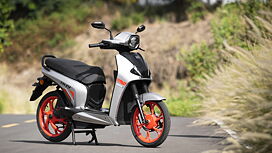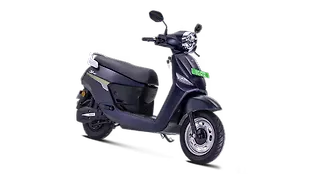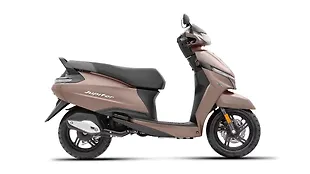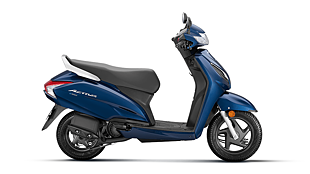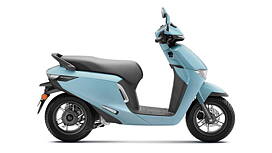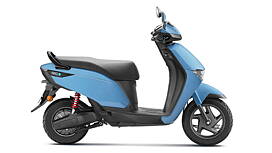Introduction

To give you an overview of the BGauss brand, it has been selling electric two-wheelers for close to four years now and claims to have sold over 40,000 EVs so far. In the last financial year, it stood at seventh position in the EV sales chart with a market share of around three per cent. They have 120 dealerships spread across 9-10 states in India. So, it’s not an Ola-like giant, but it’s serious about creating a mark in the industry.
Now, on to the RUV 350. It’s BGauss’ latest and flagship product, which looks identical to its existing D15 Pro scooter. However, besides the similarities in their body panels, everything on the RUV is new and developed from the ground up, says the company.

RUV stands for ‘Rider Utility Vehicle’ and it aims at delivering comfort, utility, and performance in a stylish package. How much of that has been achieved? To evaluate that, we got a brief stint with the scooter around BGauss’ manufacturing facility which is a closed course of well-laid tarmac.
The Looks

At first glance, the RUV 350 looks like the step-through vehicles that are popular in Southeast Asian markets. However, it’s too compact and slim to have the same kind of visual appeal. While the unconventionally large wheels do add some substance to the design, the body panels are too simple and narrow to make it eye-catching. What it does have though is a visual uniqueness with its large wheels and a tall stance.
There’s a scope for improvement in the quality department. The paint finish is a bit untidy while the uneven panel gaps and tacky plastic quality rob it of any sense of opulence. Plus, the switchgear could do with better tactility. Having said that, the company has affirmed that the final product for the customers will have better overall quality.
The Package

This is where things get interesting. The RUV runs on an unconventional In-Wheel Hyperdrive motor which is similar to a hub-mounted unit but sits slightly offset, albeit in direct contact with the wheel. BGauss says this setup delivers better performance retention in the long run over a belt-driven drivetrain. This 3.5kW motor makes a peak torque of 165Nm and delivers a top speed of 75kmph.
Powering the top-spec Max variant you see in these pictures is a 3kWh, LFP battery pack with IP 67 rating and a claimed true range of 120km in Eco mode. It also offers Ride and Sports riding modes. To keep the battery temperature in check, BGauss has a patented natural air-cooling design which allows air to efficiently pass through the body panels. Even the motor gets a passive oil-cooling system. Initially, the RUV 350 will come with a 500W charger as standard which takes over five hours to charge the battery up to 80 per cent. In the future, the company plans to sell bigger chargers with higher power ratings for a small premium.

Underpinned by a micro-alloy tubular frame, the scooter rides on large 16-inch alloy wheels with a suspension setup that has an unconventionally long travel. This has been adopted keeping poor Indian roads in mind. Braking hardware comprises a drum at both ends but a front disc variant is in the making. The inclusion of a larger rear wheel has eaten up the underseat storage space which stands at just 15 litres. To compensate for that, BGauss has equipped it with front storage pockets and a 4.5-litre storage provision in the footboard which hides under a mat.

Other features include a five-inch TFT screen (on EX and Max trims) with standard bits such as smartphone connectivity, turn-by-turn navigation, call notification, multiple themes, document storage, and ride statistics. This display has been made in-house by BGauss. Although navigating through different screens is easy, the layout and user interface don’t really feel premium and intuitive. Plus, some features weren’t active during our time with the scooter. Other features include cruise mode, hill hold, reverse mode, and regenerative braking. It weighs 122kg and sports metal body panels.
The Ride

Owing to the seat height of 785mm, getting on the RUV 350 is easy and it seats you in a natural and upright riding position. The footboard isn’t too high nor is the handlebar too close. However, the moment you stop and place your feet on the ground, you realise the seat doesn’t taper enough at the front which feels uncomfortable for the inseam. However, you get used to it over time.

Now, roll off the line and the RUV comes across as a decently quick scooter. It picks up pace briskly and the progress to 50kmph is smooth and sprightly. Even the throttle response is quite linear and predictable. However, beyond 50kmph, a strange buzz suddenly creeps in, taking you by surprise. Beyond 60kmph, it feels like every body panel is vibrating and the acceleration tapers off drastically. Despite a claimed top speed of 75kmph, the scooter struggled to cross 70kmph. One of the company representatives assured us that the vibration issue will be ironed out in the final product.

The brakes delivered a similarly underwhelming performance with an extremely soft bite at both ends. Even the lever lacked feel significantly and demanded a lot of effort to function. Although we couldn’t test the ride quality thoroughly due to the absence of broken roads around the facility, going over small rumblers and speed bumps revealed that the suspension is tuned to be on the stiffer side. You feel a violent kick at the back if you don’t slow down enough.

What turned out to be impressive was the handling. The large wheels and narrow tyres help the scooter feel agile to flick from side to side or tip into corners. It also feels decently stable mid-corners and you can go on leaning until the main stand starts scraping. Even the TVS Eurogrip tyres deliver acceptable grip and feedback.
Verdict

The whole idea of a utility and comfort-oriented electric scooter with ample tech is an attractive one. However, our short stint with the RUV 350 left us wanting more in terms of quality and finesse. The profound vibrations beyond 50kmph, lack of stopping power, and sub-standard quality levels robbed us of the novelty that this type of scooter brings to the table. It looks unique and offers a lot of features, and the long travel suspension and large wheels will surely be a boon on largely poor roads in India. It remains to be seen how the scooter fares in our detailed road test review in terms of battery range, ride quality, and other practicality-related aspects.

At the time of writing this review, BGauss didn’t reveal the price of the RUV 350. Considering the competition in the electric two-wheeler space is stiffening and the rivals are ready with potent offerings, BGauss needs to iron out the aforementioned niggles. Plus, the brand is fairly new, which makes the reliability and service experience questionable.
Lastly, to make its presence felt, BGauss should’ve priced the RUV 350 more competitively as the current prices look a little steep considering the kind of package you have on offer. It will come in three variants – 350i EX, 350 EX, and 350 Max which cost Rs. 1.10 lakh, Rs. 1.25 lakh, and Rs. 1.35 lakh, respectively (all prices are ex-showroom). While the top-end variant offers a true range of 120km, the other two can run for 90km on a single charge. They also differ in terms of display as the entry-level variant gets a segmented dash while the EX and Max trims offer a TFT screen.
Photography by Kaustubh Gandhi
Gallery
1/96
BGauss RUV350 Pillion Footrest
Double Tap to Zoom
















